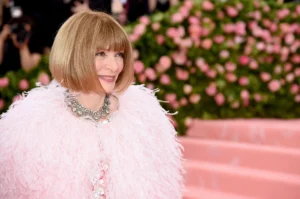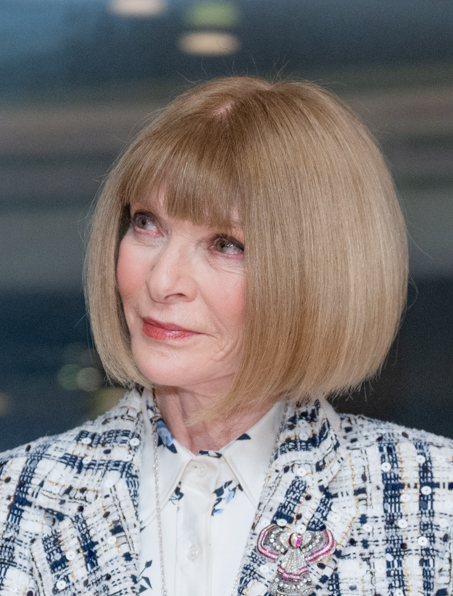📌 Introduction

Few figures in modern media wield as much power and mystique as Anna Wintour, the Editor-in-Chief of Vogue and the Global Chief Content Officer of Condé Nast. Known for her signature bob haircut and dark sunglasses, Wintour has ruled fashion media with a unique mix of discipline, vision, and cultural savvy.
This article explores Anna Wintour’s life, her rise through the ranks of fashion publishing, her influence over celebrity culture, and her enduring legacy in 2025 and beyond.
👶 Early Life & Background
Anna Wintour was born on November 3, 1949, in Hampstead, London, into a family deeply involved in publishing and politics. Her father, Charles Wintour, was the editor of the Evening Standard, and her mother, Elinor “Nonie” Wintour, was a philanthropist.
-
Her maternal grandfather was a military officer.
-
At 15, she adopted her now-iconic bob hairstyle.
-
She left school early, believing education couldn’t match real-world experience.
Her independent thinking and fashion instincts were evident from a young age.
✨ Entry into the Fashion World
Wintour’s first job was at Harper’s & Queen in London in 1967. In the 1970s, she moved to New York and took editorial roles at publications such as Harper’s Bazaar, Viva, and New York Magazine.
Her editorial style stood out:
-
Bold ideas and demanding standards.
-
Mixing affordable and high-end fashion (a trend she later made global).
-
Reimagining photo shoots with exotic, cinematic flair.
🇬🇧 British Vogue: A Game Changer
In 1986, she became the Editor-in-Chief of British Vogue. There, she began revolutionizing the publication with a fresh, empowering tone. She wanted to speak directly to the ambitious, fashion-forward woman—not just the upper class.
She replaced the “tired old posh” tone with vibrant, working-woman energy. British Vogue flourished, and Wintour was soon called to revamp House & Garden in the U.S., rebranding it as HG.
🇺🇸 Taking Over American Vogue (1988–2025)
💡 A Revolutionary First Issue

In 1988, Anna was named Editor-in-Chief of American Vogue. Her first cover shocked the fashion world—model Michaela Bercu wore a $10,000 Christian Lacroix jacket with $50 denim jeans. The message was clear: fashion was about contrast, accessibility, and real women.
🎬 Elevating Celebrity Culture
Wintour transitioned Vogue’s focus from supermodels to celebrities. Under her reign, the cover featured:
-
Michelle Obama
-
Beyoncé
-
Rihanna
-
Zendaya
-
Kim Kardashian & Kanye West
She merged fashion with politics and pop culture, ensuring Vogue remained relevant in every era.
📰 Internal Link: For more iconic women like Anna Wintour, read Top Women Power Influencers of 2025
👗 Power Behind The Met Gala
Wintour became chair of the Metropolitan Museum of Art’s Costume Institute Gala in 1995. Under her, the Met Gala:
-
Became fashion’s biggest night.
-
Raised over $250 million for the Costume Institute.
-
Mixed fashion, celebrity, and philanthropy with unmatched glamour.
In 2014, the museum honored her legacy by renaming the space the Anna Wintour Costume Center.
💼 Global Leadership at Condé Nast
In 2013, she was promoted to Artistic Director at Condé Nast, overseeing editorial strategy for multiple brands. In 2020, she became the Global Chief Content Officer, managing all Vogue editions worldwide.
She led the launch or expansion of:
-
Vogue Arabia
-
Vogue India
-
Vogue Africa
Wintour created a unified yet diverse vision for global fashion journalism.
💬 The Real-Life “Devil Wears Prada”
The novel and movie The Devil Wears Prada are widely believed to be based on Anna Wintour. Though the film cast her as cold and commanding, Wintour embraced the satire.
She even wore Prada to the movie’s premiere!
🎬 Watch: The September Issue (2009) is a behind-the-scenes documentary that portrays her intense yet visionary leadership.
🤝 Philanthropy and Social Change
Anna Wintour is not just a fashion icon—she’s a committed philanthropist.
-
Raised over $10 million for AIDS charities since the early ’90s.
-
Funded youth mental health initiatives through New York-Presbyterian Youth Anxiety Center.
-
Supported Black designers, models, and photographers after 2020’s racial reckoning.
Her 2025 Met Gala theme—“Black Dandyism: Tailoring a New Era”—reflected a deeper commitment to inclusion and cultural depth.
🏆 Awards and Honors
Wintour’s contributions have been widely recognized:
-
Dame Commander of the British Empire (2017)
-
Companion of Honour by King Charles III (2023)
-
Presidential Medal of Freedom (2025)
👨👩👧 Personal Life
Anna married David Shaffer, a child psychiatrist, in 1984. They had two children:
-
Charles (a medical professional)
-
Katherine “Bee” (a writer and producer)
Though she divorced in 1999, Wintour later had a long-term relationship with investor Shelby Bryan. Despite a high-powered image, she’s known to play tennis, spend time with her grandchildren, and care for her dogs.
🔄 Leadership Style: Commanding but Compassionate
Wintour’s nickname—“Nuclear Wintour”—reflects her intense work ethic and high standards. But colleagues also describe her as generous, focused, and highly supportive of creative talent.
Behind the sunglasses is a woman who:
-
Works late into the night.
-
Personally selects Met Gala menus.
-
Backs emerging designers without hesitation.
📰 Recent Developments (2025)
In June 2025, Wintour announced she would step down as the U.S. Vogue Editor-in-Chief after 37 years, but would continue as Condé Nast’s global chief.
Her influence remains strong—guiding Vogue’s editorial vision, mentoring new editors, and planning fashion’s biggest events.
🌐 External Link: Read more about her recent White House visit for fashion industry policy here
📈 Legacy and Cultural Impact
Anna Wintour redefined:
-
The fashion magazine model.
-
The celebrity-fueled media machine.
-
The intersection of politics, activism, and fashion.
Her legacy lives in:
-
Every September issue.
-
Every designer she elevated (e.g., Alexander McQueen, Marc Jacobs).
-
Every red carpet shaped by her style vision.
Even as she steps back from the day-to-day U.S. role, her presence is felt in every issue of Vogue worldwide.
✅ Conclusion
Anna Wintour is more than a magazine editor—she’s a force of culture. Through bold leadership, boundary-pushing vision, and tireless advocacy for inclusivity and talent, she has shaped not only the fashion industry but also how society perceives power, beauty, and influence.
In 2025, as she redefines her role once again, one thing is certain: Wintour isn’t leaving fashion—she’s elevating it, once more, on her terms.
